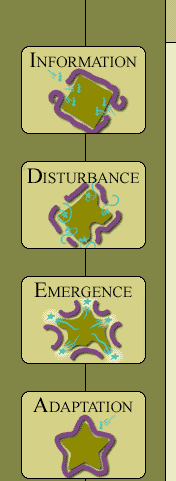



REAL Coaching offers the expertise that organizations need to rapidly develop new vision, strategies, products and structures that receive buy-in from the entire organization. “Rapid Adaptation” consulting has been used successfully for over 25 years by some of the largest corporations in the world with remarkable results. Typically, organizations are able to reduce months of work into 3 days or less using the REAL Coaching methodology and systems.
The company has developed a proprietary methodology for enabling organizations to rapidly “adapt” and thrive in a chaotic environment. The IDEA model has four primary factors:
Information: All “agents” in a system (organization) must have a clear perspective on relevant current data in order to adapt
Disturbance: Pushing a system to a chaotic state disrupts its paradigms and eliminates barriers to imagining and creating new realities
Emergence: Bringing a system back to the “edge of chaos” and re- focusing on reality allows the agents to see the clear solutions to their challenges
Adaptation: Making the small immediate changes necessary to implement the emerging solutions.
This model is based on recent breakthrough understanding of living systems and complexity. REAL Coaching’s fundamental value rule is: “small incremental changes yield big organizational impact.”
![]()
REAL Coaching’ value proposition is realized when an organization experiences “Rapid Adaptation”. The 1-3 day REAL Labs are designed to facilitate the “agents” (or participants) through four essential “states of being” that lead to system wide pro-active change.
Current State: “The Perspective/Perception Point”
Vital information is presented and processed on current state of organization (internal & external). The key objective is to surface the current individual and collective perspectives and perceptions of the organization.
Chaos State: “The Projection Point”
Small groups of agents perform “projection experiments” designed to disturb their current paradigms and stretch their imagination. The key objective is to surface models of extreme, often improbable, future states using metaphors, scenarios, games, activities and silence (meditation, prayer). This disruption of system is a catalyst for innovation and creativity.
Clarity State: “The Prescription Point”
Individual agents perform “prescription experiments” designed to create prototypes of the possible future (adapted) organization. The key objective is for each individual agent to devise and present their “formula” for success with an emphasis on small, incremental immediate (and short term) changes and initiatives. Individual formulas are shared and combined (in small groups) to create collaborative prototypes. Small groups prototypes are refined to progressively higher levels of efficiency (emergence) through iteration based on cross-system feedback.
Change State: “Pro-Action Point”
Small ad-hoc groups (based on affinity and strengths) perform “pro-action experiments” designed to immediately set in motion the adaptation of the organization based on the emerging high-level prototypes. The key objective is to identify small incremental changes that would be made within 6 months. Each group produces a plan that follows the following progression:
- What will we do now?
- What will we do within 30 days?
- What will we do within 90 days?
- What will we do within 6 months?
Each “small change” includes a deadline and a person or group responsible. Common “small change” areas include:
- Behavioral shifts (individual, organizational)
- Financial efficiency (cuts, reallocation)
- Program improvements
- Structural changes (leadership, management, etc.)
- Communications/education strategy shifts
- Policy changes

